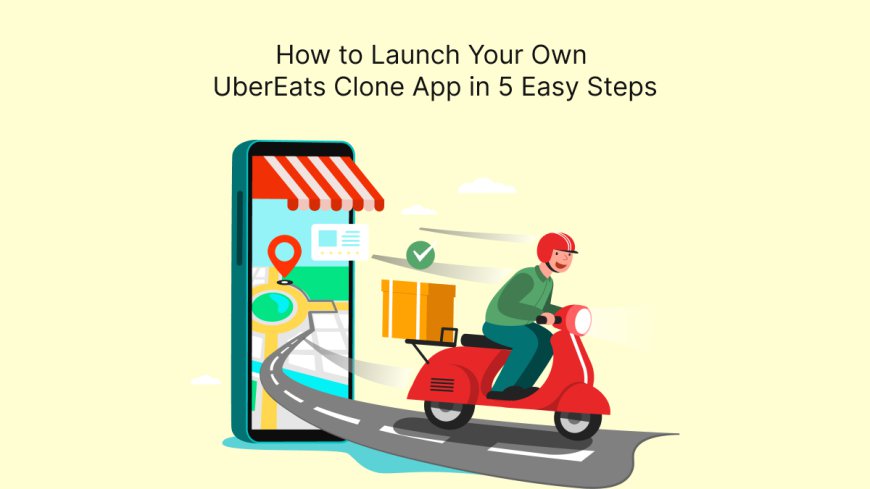How to Launch Your Own UberEats Clone App in 5 Easy Steps
Learn how to create your own UberEats clone app with this step-by-step guide. Discover essential tips on market research, technology choices, core features, UI/UX design, testing, and marketing to successfully launch a competitive food delivery platform.

As the demand for food delivery apps grows, creating your own app like UberEats clone app can be a lucrative business opportunity. By following a clear roadmap and choosing the right tools, you can launch a reliable and engaging food delivery platform. Here’s a step-by-step guide to help you launch your own app successfully.
Step 1: Research and Define Your Niche
Before developing an UberEats clone, research your target market and identify any gaps or specific needs in your area. Understanding your audience will help you define the app’s key features and tailor them to meet user expectations.
-
Competitor Analysis: Identify competitors in your market and examine their strengths and weaknesses.
-
User Preferences: Learn what users value most, such as fast delivery, specific cuisines, or promotional offers.
-
Unique Selling Proposition: Consider offering unique features, such as exclusive deals, real-time order tracking, or eco-friendly packaging.
Clearly defining your niche will give your app a competitive edge and attract a loyal customer base.
Step 2: Choose the Right Technology Stack
A solid tech stack is essential to building a stable, user-friendly, and scalable UberEats clone app. Selecting the right front-end and back-end technologies will ensure a smooth user experience, especially when handling high volumes of users.
-
Front-End Development: Use React Native or Flutter to create cross-platform apps that work on both iOS and Android.
-
Back-End Development: Opt for Node.js, Laravel, or Django for server-side operations.
-
Database: Use databases like MySQL, MongoDB, or PostgreSQL to store user information and transaction records securely.
-
Payment Gateway: Integrate secure payment gateways like Stripe, PayPal, or Razorpay to facilitate smooth transactions.
-
APIs for Maps and Notifications: Google Maps or Mapbox APIs can handle location tracking, while Firebase or Twilio can manage real-time notifications.
Choosing the right tech stack ensures a smooth, fast, and secure experience, which will encourage user retention and attract new customers.
Step 3: Build Essential Features
An effective UberEats clone app should provide core features that make ordering food easy and convenient for both customers and restaurants. Here’s a breakdown of essential features for each user type:
User Features
-
User Registration: Enable easy sign-up through phone numbers, email, or social media accounts.
-
Restaurant Listings: Offer a list of restaurants with detailed information, including menus, ratings, and delivery times.
-
Order Tracking: Provide real-time tracking of orders so users can see when their food will arrive.
-
Multiple Payment Options: Include various payment methods, from credit/debit cards to e-wallets and cash-on-delivery.
-
Ratings and Reviews: Allow users to rate their experiences, which helps others make informed decisions.
Restaurant Partner Features
-
Profile Management: Allow restaurants to manage their profiles, including menu items, prices, and operational hours.
-
Order Management: Provide tools to accept, prepare, and track orders in real time.
-
Sales Analytics: Display detailed reports on sales, popular dishes, and customer preferences.
Admin Features
-
User and Restaurant Management: Control user and restaurant data, and monitor performance.
-
Order and Payment Tracking: Oversee order statuses and ensure payments are processed correctly.
-
Promotional Management: Set up promotions and discounts for specific restaurants or user groups to encourage more engagement.
Including these core features will make your UberEats clone app versatile and appealing to both customers and restaurant partners.
Step 4: Focus on UI/UX Design
An intuitive, visually appealing design is crucial for user satisfaction. Make sure the user interface (UI) is clean, modern, and easy to navigate. Focus on:
-
Simple Navigation: Organize menus and categories logically so users can easily find what they want.
-
Clear Call-to-Action Buttons: Include prominent “Order Now” and “Track Order” buttons.
-
Personalization: Offer personalized recommendations based on users’ past orders or preferences.
-
Consistency: Maintain a consistent color scheme, fonts, and iconography to reinforce your app’s branding.
Investing in UI/UX design ensures users have a seamless experience from start to finish, which can increase order frequency and customer loyalty.
Step 5: Test, Launch, and Market Your App
Testing is essential to ensure a smooth launch. Conduct both manual and automated testing to identify and fix bugs. Consider launching a beta version to get feedback and make any necessary adjustments before the official release.
Once you’re confident in your app’s functionality, focus on marketing strategies to gain traction:
-
Social Media Campaigns: Use platforms like Instagram, Facebook, and Twitter to reach potential users.
-
Influencer Partnerships: Collaborate with local influencers or food bloggers to promote your app.
-
Launch Discounts: Offer discounts or free delivery for first-time users to attract downloads.
Marketing will help create awareness and encourage new users to try your app, setting you up for a successful launch.
Conclusion
Launching an UberEats clone app requires careful planning, the right tech stack, essential features, a strong UI/UX design, and effective marketing. By following these five steps, you can create a powerful food delivery platform that caters to modern users’ demands for convenience and speed.

 daisyscott
daisyscott